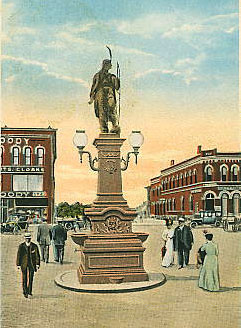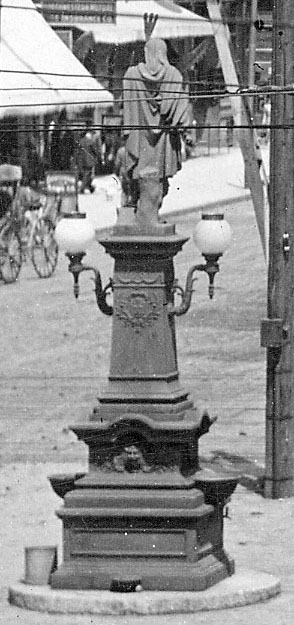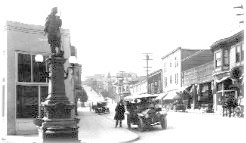Indian Statue

In 1908 an unnamed statue of a male Indian, without tribal affiliation, was erected at the head of Broadway—an area sometimes referred to as Broadway Square. The statue was cast by an iron works in New York City, shipped to Broadway, and placed in the center of Broadway just south of the NP tracks. There it stood silently staring northward for 40 years.
The Indian Statue was initiated by the Fargo Humane Society with the idea that the base of the statue would provide a watering trough for horses. Horse owners soon protested that a public watering trough could spread disease and the fountain was turned off.

The Indian warrior continued to gaze northward up Broadway until a truck banged into the statue (I believe in the 1940s). The damaged statue was trucked away to the city garage where it sat gathering dust. In 1948, a Fargo businessman told the City Council that he was prepared to buy the statue and put it in the estate of a friend. The Pioneer Daughters of North Dakota protested that the statue should have a home in Fargo. As a result, the statue was rebronzed and in December 1949 it was placed in NP Park.
The park, unfortunately, was turned into a parking lot in 1958 and the statue was once again hauled off to gather dust, this time in the Fargo Street Department. The statue was used a part of a protest in the Fargo City Hall in September 1959, when Mayor Lashkowitz locked the vault to the city auditor’s office over accusations over illegal transactions. Street commissioner P. K. Lewis used the statue as a symbol of protest placing it next to his office door. The photograph of the statue in front of his door circulated on the Associated Press. The statue rose once again, however, in 1961 when Street Department Superintendent Jorgen Miller had the statue fixed, cleaned, repainted bronze, and bolted to a concrete base next to the Street Department warehouse at 4th Street and First Avenue South.
Sometime around April 18, 1965, the statue was cut at the ankles and removed from its concrete base by vandals. The statue was discovered in an alley behind the home at 1524 11th Street N. Besides missing its feet, the statue’s right arm was broken off. According to the The Forum, the damaged statue was being brought to the city shops, where Jorgen Miller planned to make repairs. What became of the statue after that is unknown. Jorgen Miller was forced to resign due to poor health in 1968, and the city shops were moved for Urban Renewal. What became of the statue us unknown.
The above information is from a 1961 Fargo Forum article found and provided by John Hallberg. Thank you John!
 Statue in Point Richmond, California
Statue in Point Richmond, California
The Point Richmond, California, Women's West Side Improvement Club decided to place a large fountain at the apex of the downtown Triangle at Park Place and Washington Avenue. After considerable research, they selected a large fountain which could accommodate horses dogs and humans. Ordered from J.L. Mott Iron Works in San Francisco, it was unveiled in 1909, revealing an impressive Indian statue atop the large fountain structure. The statue presided over the business district until one night in 1943, when a local truck driver, leaving one of the local bars, backed into the fountain, knocking the statue to the ground. This was in the midst of World War II, when every scrap of metal was precious, and, as the story goes, city maintenance crews picked up the pieces, which were used either for the 'war effort' or for local repair parts.
The statue, and its base, are the same as that in Fargo. Its fate was remarkably similar.
 Statue in Calhoun, Georgia
Statue in Calhoun, Georgia
A Mott Iron Works Indian statue stands today in Calhoun, Georgia which is about 45 miles south of Chattanooga. It is said that this is Sequoah, a Cherokee. The picture of the Calhoun statue, shown in color to the right was generously provided by Wes Schultz of Chattanooga.
This is undoubtedly the best picture of what Fargo's copy once looked like.
